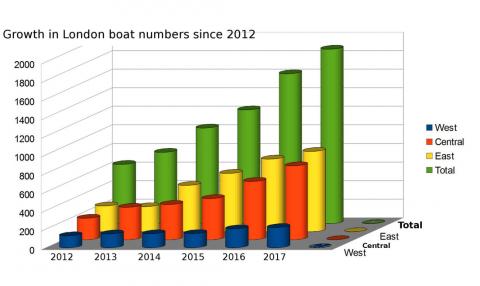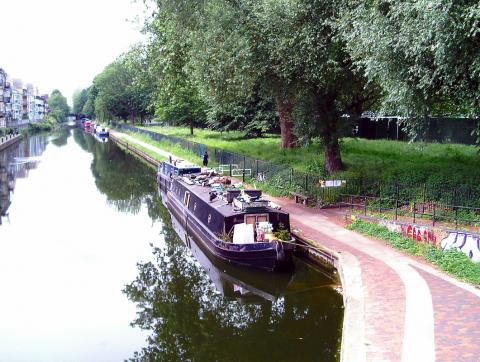Empire building Ombudsman's Committee rejected most complaints
September 2017 - The Waterways Ombudsman, currently financed by Canal & River Trust, with two out of five committee members appointed by them, is now aiming to extend itself to other waterways despite boaters' doubts about independence, as Peter Underwood reports.
C&RT tries to maintain the idea that this committee is independent and the rules of the Committee require there to be a majority of independent members and for the Chair (who must be an independent member) to have a casting vote in the event of a deadlock.
The scheme is supposed to be accountable and transparent to users of the Canal & River Trust and its subsidiaries, but it took a Freedom of Information request from The Floater's Allan Richards to see a copy of the committee minutes – and then they showed C&RT's Janet Hogben, a C&RT Trustee, as an 'independent member, something that has been corrected in the annual report. (Independent? Really?)
In fact the latest report shows that the only contact the Ombudsman has had with boaters has been to meet with representatives of the Residential Boat Owners’ Association, an organisation recently much discredited in the eyes of many liveaboard boaters.
Despite that the Ombudsman Committee has been empire building and reports it is “in correspondence with a number of other canal operators to discuss the possible membership of the Ombudsman scheme”.
The independence of the committee was not enhanced by the appointment of Janet Hogben, the chief 'people officer' at EDF Energy, who has no apparent connection connection with Inland Waterways other than her flat overlooking the Regent's Canal in the Kings Cross/St. Pancras area.
Over the past year the Waterways Ombudsman has been spending time investigating complaints from local residents in that area about smoke from boat stoves, noisy generators and general anti-social behaviour.
As The Floater reported earlier this year - it might be a coincidence that the committee minutes state 'resolution of Regent's canal cases resides within the Trust's policy and that one of the Ombudsman's documented cases starts “Ms K lives in a flat overlooking the Regent's Canal near St Pancras. She complained about nuisance from smoke emitted by boats, noise, which was mainly from engines or generators running sometimes at unsocial hours, and bad behaviour in the form of threatening or upsetting interactions with some of the boaters concerned.”
The Ombudsman, Andrew Walker reports he completed 17 investigations in the year including four complaints about the continuous cruising guidance, three from residents about the impact of boaters mooring outside their properties, and two about damage to boats from underwater hazards.
Of the investigations he completed, he partly upheld two and in two other cases he did not uphold he recommended that the Trust make a goodwill award for shortfalls in customer service.
In two investigations he decided not to make a finding, explaining: “These were very complex cases intrinsically linked with the Trust’s London Mooring Strategy and a steady increase over a number of years in the number of boats in the London area.”
He did not uphold the remaining 12 cases.
He says there were four complaints about licence restrictions for boaters without a home mooring: “Given the Trust’s increased enforcement of the continuous cruising (CC) guidance it was not surprising to receive more complaints than in previous years, but they did throw up issues of concern which I have drawn to the attention of the Trust.
“In case 915 the Trust did accept that it had incomplete sightings data, and once this was corrected the restriction was lifted and the boater was allowed to have a full 12 month licence. It also highlighted the need for boaters to keep the Trust updated about mooring status, because in this case the boater had not notified the Trust that he had taken a winter mooring.
“Two of the cases raised issues about the way in which the Trust assessed compliance with the CC guidance.
“The Trust’s legislation requires BWHM to satisfy it that the boat will be used bona fide for navigation throughout the licence period, and it has issued formal guidance (over a number of years) which explains its understanding of these statutory requirements.
“At the time of these complaints the Trust’s guidance required boaters to exceed the minimum distance (defined as “15-20 miles”), and to demonstrate that they had done so over the course of the year.
“The complainants had argued that the guidance was not clear and/or ambiguous. I noted that the existing guidance meant that boats would be assessed for only 10 months of the licence year (the final two months being to allow for the licence renewal process).
“When I raised this point with the Trust it did say that it had decided that in future it would use a 12 month period where the licence was a renewal, which would include sightings data for the final two months of the previous licence period.
“Although I did not uphold either complaint, my view was that the Trust’s online guidance was not as clear as it could have been. I did make suggestions on how it could be improved and clarified, which the Trust were happy to take on board.
“There are areas on the canal network where there are high concentrations of Boats Without a Home Mooring (BWHM), one of which is the western end of the Kennet & Avon Canal.
“The increase in enforcement activity by the Trust has led to some BWHM, especially those with school age children, saying that they have had difficulty complying with the CC guidance, although the Trust has pointed out that some boaters with school age children do comply. I know that the Trust is aware of the difficulties, and has been working with boaters to develop proposals to better enable those boaters to comply with the guidance.
“My view is that any improvements in the Trust’s guidance, as well the provision of greater clarity on what would, or would not, be acceptable cruising patterns, would be likely to reduce any scope for uncertainty.”
The Ombudsman also deals with complaints from canalside residents – three in the past year, two relating to the Regents Canal in Camden and Islington, about problems from boaters causing pollution, such as from diesel generators, engines or stoves, as well as noise, such as chopping wood or playing music.
He says: “It was clear that some boaters were flouting the regulations, for example by creating noise or using generators during unsocial hours, but there were much more fundamental problems.
“The number of boats on London’s waterways is increasing and the Trust has no powers to restrict the number of boats in the capital,” clearly echoing the Canal& River Trust's often repeated mantra about London.
Mr Walker goes on: “I explored many possible solutions, and had many meetings with the Trust, as well as with the complainants and their neighbours, Councillors, caretaker boaters and other stakeholders. The causes of the problems were deep-rooted, and I concluded that the solutions lay in a combination of enforcement and the Trust’s policies.
“Towards the end of my investigations there were advanced proposals for the installation of electricity bollards, which had from the start been suggested as the most effective single way to avoid the noise and pollution from generators and engines. In both cases there were no requirements that I could have made which hadn’t already been considered or weren’t matters of Trust policy.”
There were also two investigations about damage to boats caused by an underwater object. One complainant argued that the Trust had shown “a serious and persistent failure” to discharge its statutory duty to ensure a prescribed depth of navigation on a particular area of it network.
C&RT was having none of it and claimed that (even if it could be shown that the Trust had not met this duty, which it did not accept) the wording of the statute was clear that the only remedy was to seek a court order to enforce the duty (e.g. by dredging) rather than an action for damages in respect of damage to a boat as a result of this lack of navigation depth.
Perhaps boaters will be unsurprised to learn that Mr Walker: “... concluded, based on my understanding of situation and the law, that in both cases the Trust was not liable for the damage caused to the boats.”
He did add that his decision: “may not be the only conceivable conclusion, and that it was possible that a court or other dispute resolution body would reach a different conclusion”.
In fact C&RT is not keen to take responsibility for anything much and the Ombudsman investigated a claim from a disabled boater without a home mooring, who had had difficulties in getting the Trust to make reasonable adjustments to enable him to comply with the CC guidance.
C&RT first tried to argue that the Ombudsman shouldn't look at the case then claimed it had 'acted in the genuine belief that it had dealt properly with the request'.
The Ombudsman says: “My view was that it could have acted more promptly and helpfully, and I required the Trust to make a goodwill award.”
He goes on to say: “The case highlighted the need for the Trust to engage fully and as early as possible in any future cases of this nature.”
In summary the Ombudsman and his committee seem to have spent more time dealing with complaints from NIMBY residents living alongside the canals in London than the concerns of boaters and to have backed C&RT in the vast majority of cases – including those centred around their negligence of the primary duty of keep the canals navigable.
In some cases he has simply given up trying to make a decision. On that basis other navigation authorities will probably welcome the committee's advances with open arms.
Photos: (1st) Janet Hogben, the chief 'people officer' at EDF Energy, (2nd) C&RT's take on boat numbers, (3rd) Boats moored at London's Victoria Park.








